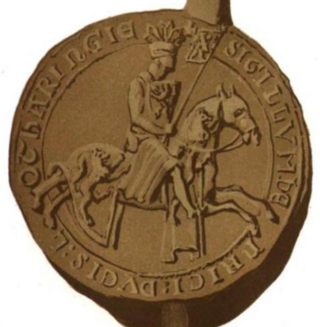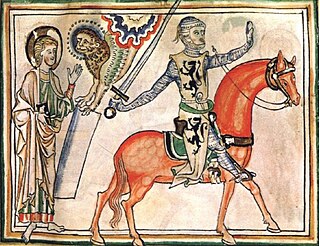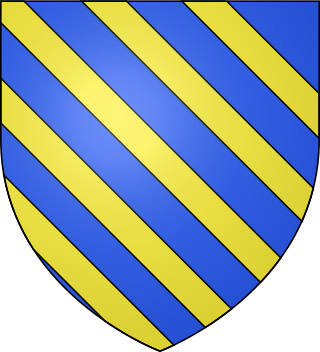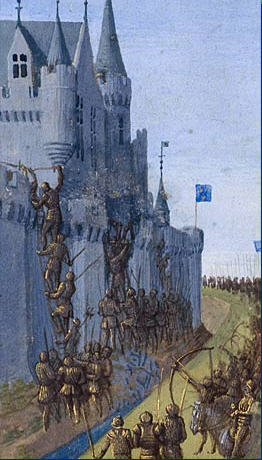
Henry II of Brabant was Duke of Brabant and Lothier after the death of his father Henry I in 1235. His mother was Matilda of Boulogne.

William de Valence, born Guillaume de Lusignan, was a French nobleman and knight who became important in English politics due to his relationship to King Henry III of England. He was heavily involved in the Second Barons' War, supporting the king and Prince Edward against the rebels led by Simon de Montfort. He took the name de Valence after his birthplace, the Cistercian abbey of Valence, near Lusignan in Poitou.

Guy of Dampierre was the Count of Flanders (1251–1305) and Marquis of Namur (1264–1305). He was a prisoner of the French when his Flemings defeated the latter at the Battle of the Golden Spurs in 1302.

Mahaut or Matilda II of Boulogne was Countess of Boulogne in her own right and Queen of Portugal by marriage to King Afonso III from 1248 until their divorce in 1253. She was the daughter of Ida, Countess of Boulogne and her husband and co-ruler Renaud, Count of Dammartin. She succeeded her mother as Countess of Boulogne in 1216. She was the great-granddaughter of King Stephen of England.

Marie de St Pol, Countess of Pembroke was the second wife of Franco-English nobleman Aymer de Valence, 2nd Earl of Pembroke, and is best known as the founder of Pembroke College, Cambridge.

Guy III of Châtillon, Count of Saint-Pol was a French nobleman, and was a younger son of Hugh I, Count of Blois, and Mary, Countess of Blois.

Guy IV of Châtillon, Count of Saint Pol was a French nobleman. He was the son of Guy III, Count of Saint-Pol and Matilda of Brabant.

Matilda of Brabant was the eldest daughter of Henry II, Duke of Brabant and his first wife Marie of Hohenstaufen.

Walter III of Châtillon was a French knight and Lord of Châtillon, Montjay, Troissy, Crécy et Pierrefonds until his death in 1219. With his marriage, he became Count of Saint-Pol. He was also the Butler of Champagne and the Seneschal of Burgundy.

The House of Bethune is a French noble house from the province of Artois in the north of France whose proven filiation dates back to Guillaume de Béthune who made his will in 1213. This family became extinct in 1807 with Maximilien-Alexandre de Béthune, Duke of Sully (1784-1807).

Clan Bethune is a name for one the Scottish families using the last name of Bethune, in this case descendants of the lairds of Balfour in Fife, an estate in the Lowlands parish of Markinch. Originating before the year 1000 in the town of Béthune, then in the county of Flanders, over the centuries the pronunciation of the family name shifted from the original French bay-tune to the Scots bee-t'n, usually written Beaton. From about 1560, members of the family started using the French spelling again.
Baldwin of Béthune or Baldwin de Béthune, a French knight from the House of Béthune in Artois and a crusader, was close companion to successive English kings and on marriage to Hawise of Aumale became Count of Aumale with extensive estates in England.

Matilda of Béthune, was a noblewoman from Artois who became countess of Flanders by marriage to Guy, Count of Flanders. She was heiress to her father's titles as Lady of Béthune, of Dendermonde, of Richebourg and of Warneton, as well as Advocatess of the Abbey of Saint Vaast at Arras, and the ruler of these states in 1248-1264. She was the mother of Robert, Count of Flanders, known as Robert of Béthune after his mother.
Robert de Béthune VII was a nobleman from the House of Bethune from Artois. He served as a knight and military leader in Flanders and England before inheriting his family territories in France and the Low Countries. He joined the Seventh Crusade, but died en route to the eastern Mediterranean.

William II, Lord of Béthune, nicknamed William the Red was French nobleman. He was a ruling Lord of Béthune, Richebourg and Warneton, as well as hereditary advocatus of the Abbey of St. Vaast, near Arras.
Hugh IV of Saint-Pol from the House of Campdavaine, son of Anselm of Saint-Pol, was count of Saint-Pol from 1174 to his death, and lord of Demotika (Didymoteicho) in Thrace in 1204–05. He participated in the Third and Fourth Crusades.
Matilda I, Countess of Nevers or Mathilde de Courtenay, or Mahaut de Courtenay, (1188–1257), was a ruling countess of Nevers, Auxerre and Tonnerre. She was the only daughter of Peter II of Courtenay and of Agnes of Nevers, born from the Capetian House of Courtenay, she was married to Hervé IV of Donzy and then to Guigues IV of Forez.

Guy IV (c. 1197 – 1226) of the House of Châtillon was the de facto count of Saint-Pol as Guy II from 1219/1223 until his death.

Elizabeth, in French Élisabeth Candavène, was the countess of Saint-Pol from 1205 until her death, although her effective rule was limited to the periods 1219–1222 and 1226–1227. The rest of the time the county was ruled by her first husband and by her sons. From 1196 to 1219, she was married to Lord Gaucher III of Châtillon. From 1228 until 1238, she was married to the landless John of Béthune. She was a patroness of the Cistercians.
John of Béthune was a French nobleman and military leader in the County of Artois.















